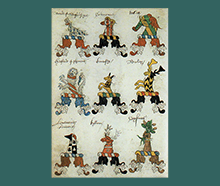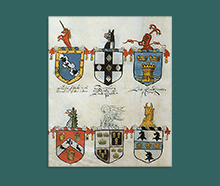Excuse Me, But There's No Such Thing As A Family Crest
The Term "Family Crest" -- A Problem of Semantics?
Confusion over the term "family crest" probably arose from an understandable abbreviation of the terminology in heraldry for an important part of a coat of arms. One of the most respected sources for heraldry information is Fairbairn's Book of Crests of the Families of Great Britain and Ireland, first published in 1859 and revised over the years in various reprints. (The current version is published by the Genealogical Publishing Co., Inc. in Baltimore, Maryland.) It is not difficult to see how the use of the term "crest" could have become synonymous in common use with the term "coat of arms," since one is a part of the other (see A Brief History of Heraldry and the Parts of a "Coat of Arms" or "Family Crest".) Through time, "the crest" has been associated with family names, independent of the coat of arms, in such publications as Fairbairn's.
Gaelic tradition allows family members to use of the "crest" part of an entire coat of arms (that which appears above the shield) in a badge setting (a circular belt), thus all members of a given clan are entitled to use the clan badge. Indeed, the crest part of a coat of arms has been used on engravings, rings, bookplates, and other means of displaying one's heritage for many years. Perhaps this is due to their relative simplicity in relation to the full coat of arms. However, authorities claim that they were never intended to be used alone, without the remainder of the official coat of arms.
A previous editor of that esteemed "Fairbairn" book described the "crest" as "that part of the complete achievement which is placed upon and surmounts the coronet, wreath, or chapeau, which in its turn is above the mantling or lambrequin which it is supposed to attach to the helmet."
Coats of Arms and Crests Belong to Individuals, Not Surnames
Coats of arms are not awarded to a family or a name, but to an individual. This is why there is no coat of arms or family crest for the family name "Hardin" -- only a coat of arms and crest granted to someone with that name many years ago. This is why there is often more than one coat of arms associated with a given surname. See the various Hardin coats of arms and various Hassell coats of arms from different countries and regions. In England, direct descent is required for any heir to have the legal right to bear his ancestor's coat of arms.
You can try to narrow the search by geographic region of origin, but there may also be more than one coat of arms awarded to several people in ancient regions. Further complicating the issue is that the authoritative source information for most coats of arms only lists a city and/or county or origin, and sometimes only a country.
That is why, unless you can trace (and document) your family history to one individual, then the best that you can hope for is to find a coat of arms that is the oldest for a given name from a given region or the one most frequently used, and include part of that design in your new, custom coat of arms. Coats of arms usually started out fairly simple in design, then subsequent generations added onto or made slight variations to the design to make it their own. Marriages often resulted in a combination of two different family lines' coats of arms.
You can also try contacting the College of Arms for the country you believe your ancestor is from, and for a fee they will search their records to see if a coat of arms was awarded to your ancestor.
The earliest coats of arms were fairly simple -- bars or wavy lines, a lion rampant or an eagle displayed, or an arrangement of fleurs-de-lis. The designs became more complex as the years passed, and the practice of quartering (incorporating the arms of other families acquired through marriages) developed.
What About "Clan Crests"?
A Scottish crest badge is a heraldic badge worn to show allegiance to an individual or membership in a specific Scottish clan. Crest badges are commonly called clan crests, but there is no such thing as a clan crest, just as there is no such thing as a family coat of arms or crest.
Although "clan crests" are commonly bought and sold, the heraldic crest and motto belong to the chief alone and never the individual clan member
I Was Always Told This Is My Family's Coat of Arms or Crest!
The bearing of coats of arms is not regulated in most countries, including the United States, thus there has been a proliferation of "family name" companies offering histories and coats of arms for a given surname. While there is no reason we cannot enjoy the decoration of a coat of arms associated with someone centuries ago who shared our surname, we should be aware that this is all that it is -- a decoration.
There is also no reason we cannot create a coat of arms and crest for ourselves, whether based on the coat of arms of an ancestor who shared our name (and may or may not be related to us), or designed from scratch to mean something special to our own lives and family.
So... We Are Excused!
Other Topics
Can I see some examples of your design work?
Of course! Please see our portfolio and pick some examples that you would like your design to emulate.
What if I want to have the design embroidered on clothing and accessories?
Color and detail in a digital design can look very different when converted to an embroidery format. Please see our web page about embroidery services: Embroidery
Why do some coats of arms have lines and dots?
This is called "hatching" and was used by jewelers and other artists when color was too expensive to use or unavailable.
What is Hatching?
"Hatching" is the term for representing the colors of a coat of arms in black and white. This was necessary when color printing was excessively expensive.




